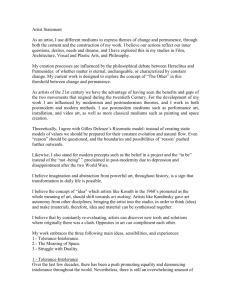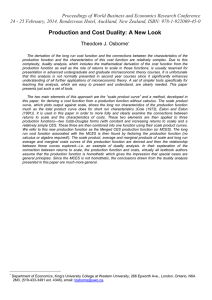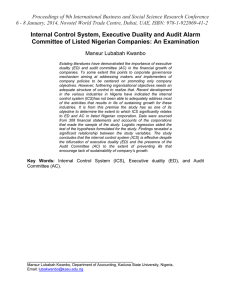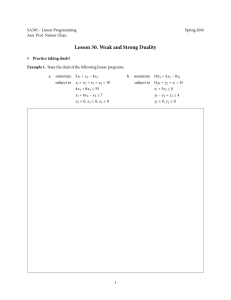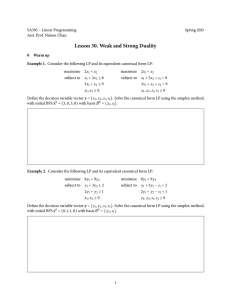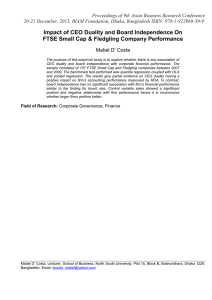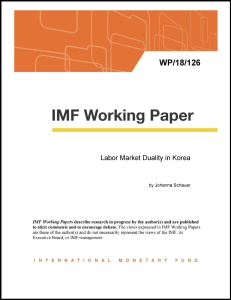The Path to Higher Growth: Does Revamping Japan’s Dual Labor Market Matter?
advertisement
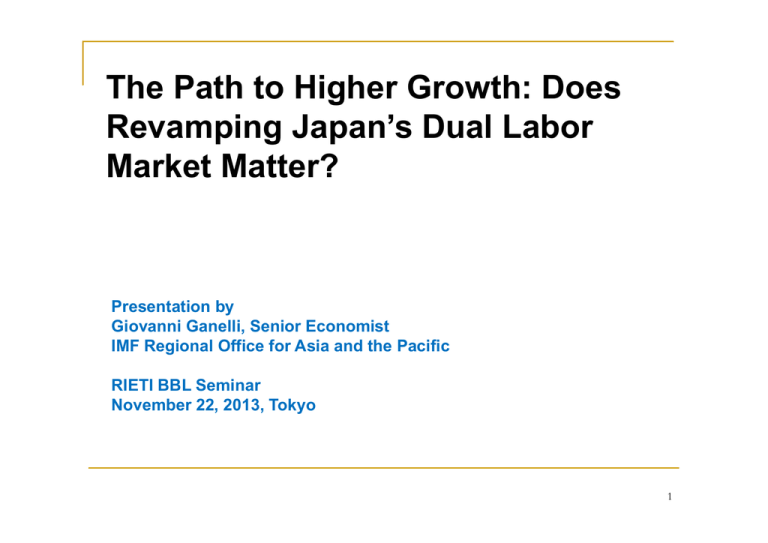
The Path to Higher Growth: Does Revamping Japan’s Dual Labor Market Matter? Presentation by Giovanni Ganelli, Senior Economist IMF Regional Office for Asia and the Pacific RIETI BBL Seminar November 22, 2013, Tokyo 1 This presentation is based on the findings of a Working Paper prepared by Chie Aoyagi and Giovanni Ganelli, available at http://www.imf.org/external/pubs/cat/longres.aspx?sk=40974.0 Disclaimer: This Working Paper should not be reported as representing the views of the IMF. The views expressed in this Working Paper are those of the author(s) and do not necessarily represent those of the IMF or IMF policy. Working Papers describe research in progress by the author(s) and are published to elicit comments and to further debate 2 Motivations: -- Japan’s labor market duality–a two-tier labor market with “regular” and “non-regular” workers– increased dramatically in recent years -- Microeconomic and cross-country studies suggest that excessive duality can reduce TFP and growth (training and effort channels) -- Need to consider this in the context of structural reforms (Japan’s growth strategy, or “third arrows” of Abenomics): how can duality be reduced? 3 Methodology and main findings: -- Cross-country (OECD) panel regression in which a proxy of labor market duality is regressed on economic, institutional, and demographic determinants -- Reducing difference in level of employment protection between regular and non-regular workers can be effective in reducing duality -- Policy implications 4 Japan’s Dual Labor Market: Some Stylized Facts Annual Change (Thousand Persons) 150 30 50 25 0 20 -50 -150 -200 40 35 100 -100 Percent Regular workers excluding executives (left scale) Non-regular workers (left scale) Share of non-regular workers (right scale) 15 10 5 0 Source: Ministry of Internal Affairs and Communications, IMF staff calculations. 5 Japan’s Dual Labor Market: Some Stylized Facts 6 Japan’s Dual Labor Market: Some Stylized Facts 90% 80% Share of Non-regular Workers Among Female Employees (2007) Total Non Married 70% 60% 50% 40% 30% 20% 10% 0% Sources: Ministry of Internal Affairs and Communications, IMF staff calculations. 7 Japan’s Dual Labor Market: Some Stylized Facts Share of Temporary Workers (2011) (%) 30 25 20 15 OECD average 10 5 0 Sources: OECD. 8 Costs and benefits of duality Benefits: -- Bring new “voluntary non-regular” workers into labor force (satisfy demand for flexible work arrangements) -- Contribute to keep overall unemployment low Costs: -- Reduced TFP and growth through training and effort channels -- Perception that growth is not inclusive can reduce support for needed structural reforms Costs likely to dominate in Japan 9 Costs and benefits of duality Japan: Labor Market Duality and Productivity by Economic Sector 700 80% 600 70% Productivity* (LHS) 500 60% Share of Non-regular 400 50% 40% 300 30% 200 20% 100 10% 0% Education, learning support Eating and drinking places, accommodations Medical, health care and welfare Wholesale and retail trade Information and communications Construction Transport Manufacturing Services, n.e.c. Finance and insurance Government, n.e.c. Electricity, gas, heat supply and water Real estate - *Productivity is measured by amount of value-added divided by number of workers. Source: Mizuho Research Institute, Ministry of Internal Affairs and Communications; IMF staff calculations. 10 Determinants of duality: panel data estimation on 17 OECD countries (annual data; 1985-2010) Model specification: 11 Table 1. Japan: Determinants of Labor Market Duality in a Panel of OECD Countries: Regression Results 1/ Dependent Variable: Share of Temporary Workers Employment Protection Legislation of Regular Workers Employment Protection Legislation of Temporary Workers FDI Outflows (percent of GDP) Female Labor Participation Share of Employment in Services Union Density Unemployment Rate Inflation Output Gap Government Spending on Vocational Training (percent of GDP) Lagged Dependent Variable R-squared Benchmark model 2/ Benchmark model 3/ Benchmark model 4/ 0.763 [2.23]** 0.763 [2.8]** 0.768 [2.38]** -0.281 [-2.47]** 0.010 [0.72] 0.094 [3.10]*** -0.192 [-5.51]*** -0.096 [-2.86]*** 0.110 [2.81]*** -0.230 [-5.19]*** 0.006 [0.16] -0.281 [-3.05]*** 0.010 [1.21] 0.094 [2.33]** -0.192 [-2.04]* -0.096 [-1.86]* 0.110 [1.68] -0.230 [-2.45]** 0.006 [0.12] -0.251 [-2.18]** 0.010 [0.85] 0.105 [3.33]*** -0.193 [-6.00]*** -0.096 [-2.96]*** 0.115 [3.17]*** -0.215 [-5.19]*** 0.005 [0.15] -0.469 [-0.82] 0.825 [26.5]*** 0.857 -0.469 [-0.97] 0.825 [40.58]*** 0.857 -0.671 [-1.18] 0.823 [26.45]*** … Source: IMF Staff Calculations 1/ T-statistics are reported in parenthesis. * denotes significance at 10% level, ** significance at 5% level, and *** significance at 1 percent level. Countries included in the panel are Austria, Belgium, Canada, Denmark, Finland, France, Germany, Ireland, Italy, Japan, Netherlands, Norway, Portugal, Spain, Sweden, Switzerland, and United Kingdom. Annual data for 1985–2010 (or less, depending on availability). A Hausman test rejected the null hypothesis that a random effects model would be statistically different from a fixed effects one. 2/ Fixed effects estimation with default standard errors. 3/ Fixed effects estimation with clustered standard errors. 4/ Arellano-Bond estimation with one lag. 12 Determinants of duality: panel data estimation on 17 OECD countries (annual data; 1985-2010) This result is robust to various specifications and estimation techniques 13 Policy implications: -- Reducing the difference in the degree of employment protection between regular and non-regular workers can reduce duality -- Estimated impact for Japan (first round effects only) could bring duality close or below 30% 14 Policy implications: 15 Policy implications: -- If, as expected, the reduction in labor market duality results in higher growth, this would reduce unemployment and help exiting deflation -- According to the econometric results presented in the study, a fall in unemployment and an increase in inflation would result in second round effects of the initial reform, which would further reduce duality 16 Policy implications: -- One way to implement the policy recommendation given in this paper could be by offering all new hires a Single Open Ended Contract (SOEC) -- Under a SOEC, employment protection and severance pay increases with tenure: less employment protection compared to current regular workers; more protection compared to current non-regulars -- A wider use of “limited regular” (“gentei seishain”) contracts is consistent with these recommendations 17 Complementary reforms also needed: -- A shift towards “flexicurity” -- Policies to increase wages -- Changing “soft institutions” 18 A shift towards “flexicurity”: increasing unemployment insurance benefits; strengthening job matching and training programs for the unemployed. 19 Policies to increase wages 20 Policies to increase wages, possible options: -- Moral suasion -- Social concertation -- Tax incentives -- Minimum wage hike 21 Policies to increase wages 22 A change in “soft institutions” 23 In summary -- Economic costs of labor duality are likely to be high in Japan -- Our analysis suggests that reducing differences in employment protection between regular and non-regular workers would reduce duality, thus raising potential growth -- Complementary reforms will also be needed 24 Thank you for your attention 25
